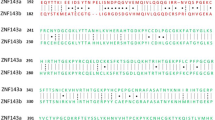Abstract.
The basic helix-loop-helix (bHLH) proteins control differentiation and development of a variety of organs. We have isolated the complementary DNA (cDNA) of a novel class of bHLH transcription factors. The previously uncharacterized bHLH messenger RNA (mRNA) was identified by RNA fingerprinting by comparing embryonic and adult mRNA. The reading frame sequence predicts a new class of bHLH family. Northern blotting of embryonic stages demonstrated a 3.2-kb transcript present in several embryonic tissues, including kidney, brain, heart, and lung, in a fashion confirmatory with the RNA-fingerprinting data. In situ hybridization of cryosections detected strong signals in the dorsal root ganglia of 14-day-old mouse embryos (E14). Transient transfection of human embryonic kidney cells with Nulp1-EGFP demonstrated nuclear localization. The complex expression pattern and unique protein sequence, including an acidic amino terminal and putative transcription activation domain, suggests that Nulp1 may have a distinct role in embryonic development of many organs, including the adult brain.
Similar content being viewed by others
Author information
Authors and Affiliations
Additional information
Electronic Publication
Rights and permissions
About this article
Cite this article
Olsson, M., Durbeej, M., Ekblom, P. et al. Nulp1, a novel basic helix-loop-helix protein expressed broadly during early embryonic organogenesis and prominently in developing dorsal root ganglia. Cell Tissue Res 308, 361–370 (2002). https://doi.org/10.1007/s00441-002-0544-9
Received:
Accepted:
Issue Date:
DOI: https://doi.org/10.1007/s00441-002-0544-9




